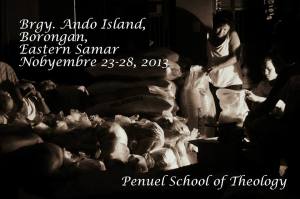By Kale Luaton

Preparation and repacking the relief goods for the people of Ando, Borongan, Eastern Samar
The vivid image of devastated landscape in Eastern Samar and Leyte keeps on haunting my memory after my last visit to help my relatives and fellow ‘Waraynon’ for an immediate relief. It is the reason why I could not even imagine how to celebrate the longest celebration of the year particularly if the appearance of distress is still confronting me face to face. For once I confronted the celebrant, “Give me enough reason to be merry. Why should I be happy for your birthday?” To my disappointment I closed my eyes and stood in silence as if I was waiting for a response. Then I heard a tiny voice said, “Tay, in na or kain na” (Let us eat). Yesnile, my son held my hand and pulled me near the dining table asking us to eat. A thought suddenly popped in, “Perhaps the answer to my question is nowhere else to be found except here in front of our dining table with my family.” While the feeling of desolation and misery continuously wounds my heart towards my townsmen in Eastern Samar, I think that some family traditions and values contribute a tremendous factor to be a resilient and strong-spirited Filipino individual in the midst and even in the aftermath of catastrophic events such as natural disasters.
I shall trace one of our family traditions and values that originated from our ancestors which shaped the old and is currently shaping the new generation in our family. It is also my task to detect the advantage and the disadvantage of the traditions and values for awareness and recommendation for improvements.
Among many festivities in the Philippines, Christmas holds the longest yearly celebration.[1] My family testifies the claim. We usually start on every 16th of December in which we attend daily Masses held before dawn until 24th followed by a hearty breakfast. After the Noche Buena, Christmas does not end up suddenly for it stretches to December 28, Feast of the Innocents, December 31, New Year Eve and finally to Epiphany.
Veneration of Our Ancestors
Christmas Eve in our family is almost always embellished with epicurean semblance of a mouthwatering banquet. Just before we jump off and feast on the table, my mother and or my grandmother will lead a lengthy prayer. The prayer includes thanksgiving and invitation to our ancestors and relatives who passed away to have fellowship with us. According to Fr. Leonardo Mercado, “veneration of the departed was the core of religion of pre-colonial Filipinos and still is that of not a few Filipino ethnic minorities. The veneration is not characterized by fear. Nor is it a deification of said ancestors. It is characterized by familiarity and communion.”[2]
When I was young, I asked my Lola why she calls the dead relatives during family gathering. She retorted that they still guide us even if they are dead and death does not end the bond of our family. Filipinos are deeply connected between his fellowmen that even death cannot separate them, as Melba Maggay puts it, “This deep sense of ‘interconnectedness’ extends to maintaining relationships with the ancestral dead. Filipinos perceive the dead to be separated from human society merely by a curtain of invisibility… For it is not, technically speaking, preoccupied with the worship of spiritual life forces, but with maintaining harmonious ties with our ancestors anitos and all other spirit beings”.[3]
This tradition is passed on from old to new generation. This is also the reason why we can still remember most if not all of our ancestors and their legacy in our family. It also strengthens our family bond. This interconnectedness makes us one though we have lots of diverse character and personality. This kind of interconnectedness also transcends from family relationship to the community. In fact almost all of our townsmen are not only related by blood but also by shared values.
Pakikiramdam
The sense of interconnectedness between family and community results to a very strong sense of Shared Inner Perception or Pakikiramdam. It is an ability to sense others’ needs, to intuitively understand their feelings, and to demonstrate compassion, empathy and sympathy in interactions with others.[4] Members of the family are more concerned for others’ feelings than about absolute truth. And many Filipinos prefer to withhold their views if expressing them might make them appear critical of others in their presence. Individuals who are ‘magaling makiramdam’ (skilled in sensing cues from others) do not wait to be told. They anticipate others’ needs. They observe, strive to understand what others expect of them, and act on the basis of what they rightly or wrongly assume to be others’ expectations. A person who does not demonstrate a similar regard for other people’s needs and feelings is seen as ‘walang pakiramdam’ (insensitive), ‘manhid’ (unfeeling), or ‘kapal mukha’ (thick-skinned; the expression refers in particular to the skin on the face).
Bayanihan
Filipinos are known to be helpful and hospitable people. This helpfulness trait is more often known as the Bayanihan. It is evident in the Filipino practices of pakikiramay (generosity and sharing in time of loss or bereavement), pakikibahagi (being an active participant in a group), tulong-tulongan (mutual helping), pag-aalaga (taking care of those in need) and pakikiisa (unity).[5] This is the main reason why Filipinos survive crises. They care for each other well. People from other countries who move or visit the Philippines are often impressed by the warmth, friendliness, and hospitality extended towards them virtually everywhere.[6]
During the time where Bahay Kubo houses were still prevalent, and drainage systems were not yet developed, all folks from the neighborhood willingly help their neighbor in transferring the wooden home to a safer place. Altogether they carry the poles that support the base of the house, bear its weight on their shoulders, and walk several miles to transfer it to its new destination. The owner thanks everyone by treating them with merienda, and together they celebrate the occasion with merry hearts.
This was also evident in the family during my Christmas break. Before, Tatay and Nanay were the ones who provide the food for the Noche Buena. But since me and my sister have our own source of income, we shared what we can provide without being told by our parents. We even took our own tasks during preparations. The ethos of pakikiramdam and bayanihan reigns inside the family not only during Christmas but in almost every day in our lives.
Limitations
It is also important to site few limits of these values so we can find alternatives or improve the way we live with these values. Attending too much on shared inner perception or Pakikiramdam might end up assuming too much and act inappropriately. There are people that only needed listeners. To act immediately might not help solve the problem or make it even worse.
While Bayanihan promotes inclusive community spirit and a sense of shared endeavor that motivate mutual assistance within groups with which we identify, it sometimes appear to consider the manner and form of interrelating with others more important than realizing the purpose of the shared activity. It also sometimes intrude privacy of an individual especially issues that should not be disclosed to anyone else.
At any rate, it is not surprising for us Filipinos as ‘insiders’ why we can surpass most if not all tragedies in our lives. The resilience and sturdiness are deeply rooted in us. These values are the bloods that circulate and the veins are our family and community. We are diverse and yet one. We face struggles together. We are interconnected that even that death cannot separate us. This is who we are. I am hopeful for a better future of our country and the values we share are our tools to live a harmonious life as an individual and as a society and not a tool for abuse to advance selfishness.
